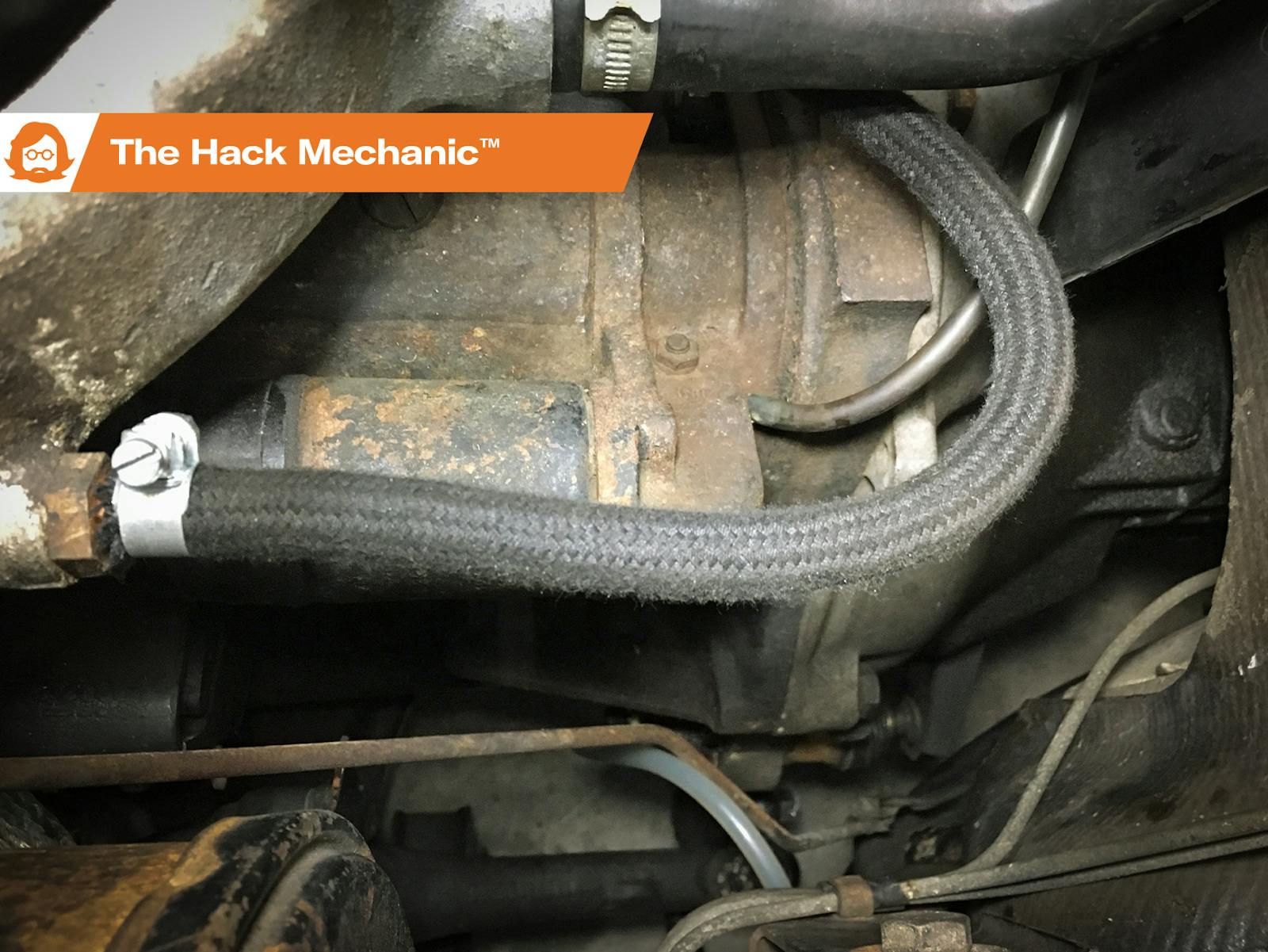The tale of the Loti: Tantalized by an Elan and Eclat, Part 2

Last week, I talked about going to see not one but two vintage Lotuses advertised on Craigslist by a seller in nearby Andover, Massachusetts. The first was a 1976 Eclat, an example of the “wedge” design that swept the automotive industry in the 1970s. On paper, it sounded interesting because it had a Rover 3500 V-8 in it, it ran, and it was cheap, but it wasn’t enough for me to allocate winter space that I didn’t really have to it.

But the other car was a 1973 Lotus Elan +2 S130, the highly desirable hardtop four-seat version of the classic Elan roadster. I’ve had a serious jones for one of these ever since I saw one at the Lotus Owner’s Gathering in Sturbridge, Massachusetts, in 2019. Unfortunately, the car’s drivetrain had been removed, its legendary 130-horsepower “Sprint specification” Lotus-Ford Twin-Cam (“Twink”) engine was long gone, and the non-Sprint-spec engine that was to take its place was in pieces and almost certainly incomplete. Someone might be willing to pay the seller’s $10K asking price, but it wasn’t me.
The seller was a guy not unlike me, maybe 10 years older, so perhaps in his early 70s. He clearly shared many of my scrappy, practical, and chaotic tendencies. His name, coincidentally, was also Rob. And, like me, he was a former software engineer whose skill set didn’t exactly have employers knocking the door down, so I felt a certain kinship with him.
Both cars had been off the road for decades, stored together in a small rented one-car garage via a brilliant—though Rube Goldberg-like—contraption utilizing four cross-braced engine hoists that suspended the Elan above the Eclat. Unfortunately, the house where the rented garage was located had been sold and was slated for condo conversion, so the clock was ticking on his getting kicked out of the garage. He just didn’t know when the alarm would go off.
I was so impressed by the ingenious way the Elan +2 had been suspended aloft for decades that it took me a while to grok the car itself. It was pretty rough. With the car hovering in the air, Rob showed me two major issues. Although the Elan +2 has a fiberglass body, it has steel sills, and on this car they’d rotted away to powder, making it so the car could no longer be raised by the factory jacking points. There was also a troubling rust area visible on one section of the frame. The fact that the car was raised made these things easy to see, but I chose to not get directly beneath it, and instead stepped around the hoists very gingerly.
I did, however, very carefully open up the doors and peer inside. I was intrigued by what I saw. Elan +2s have beautiful wood dashboards, and while this one had a good amount of veneer cracking, it still hit me in that very special place that only a vintage British car dashboard can. And, despite the decades of storage, the seats and headliner appeared to be in pretty decent condition. When I closed the door, though, the car swayed slightly on the chains suspending it, making me realize that phrases like “it hit me” are best not used prophetically.
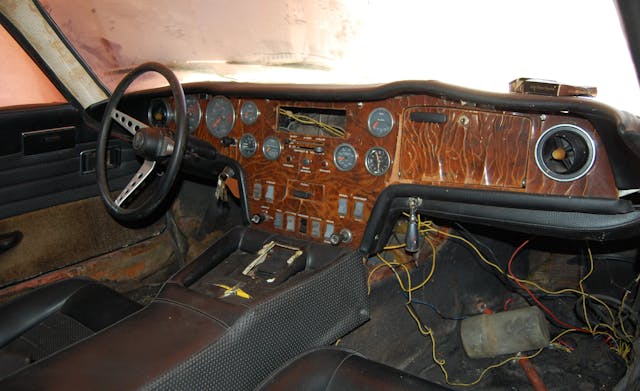


I again asked Rob about the time frame for being out of the garage. He repeated that his execution didn’t yet have a date on it, but no stay would be coming. He needed to get both cars out so he wouldn’t get caught flat-footed, but he had nowhere to put them. He only had room for one car at his rented apartment, and that car had to be his daily driver. He said that one plan was to get the Eclat running and drivable and use that as a daily, because, well, what the hell, it’s either that or practically give it away. He noted that there was a title issue with the Eclat—he swore that he’d titled it in Massachusetts but had never registered it; he couldn’t find the paper title, and the registry said there was no record of the car (old cars with short VINs can be problematic). I advised him how to legally register the car without a title.
Rob said that the immediate drivability issue with the Eclat was brakes. The car has inboard rear drums, and they and the wheel cylinders are next to the differential, making the bleed valves difficult to reach. The back of the car needs to be raised to access them, and you need to be careful jacking up cars with fiberglass bodies. I skooched beneath the back of the car and could see where the thin metal of the trailing arm attachment bracket behind the differential had been mangled by a floor jack. I said that I’d be happy to come back with some plastic ramps and a variety of bleeding tools. The subject of the Elan was more complicated. I told him about my experience with my Europa—having bought it whole and intact, but with a seized Twink engine, for six grand. I’d rebuilt the engine myself as inexpensively as possible, and I now had 20 grand into the car, so there’s no pretending the numbers to revive the Elan wouldn’t be higher.
I was there for about an hour and a half. At the end of it, I thanked the Rob for his time, said that I wasn’t interested in the Eclat, but that I’d think carefully about the Elan and get back to him.
Over the next few days, Rob and I swapped several texts. He said he’d made some progress—he’d gotten the Elan down onto the garage floor and was trying to bleed the brakes on the Eclat. I said that I’d been thinking about writing a piece about the two cars and would love to come back up there to look at and photograph the now-grounded Elan. I reiterated that I’d be happy to bring my Rhino Ramps and bleeding tools. Rob expressed concern that, without brakes, the Eclat could overrun the end of the ramps. I said there was a lip on the ends that should prevent that.
When I arrived, I began pulling the brake bleeding stuff out of my trunk, but Rob said “Look at the Elan first. That’s what you came for. Make sure you get the photographs you want.” I explained that I came for both things, but OK.
We rolled up the garage door. The Elan +2 was no longer levitating like the ’64 Chevy Malibu that Emilio Estevez and Tracey Walter hovered off in at the end of Repo Man. The car was still surrounded by junk, but at least I could get a more complete vibe and see its red paint and silver top at street level.

I looked again at the Elan’s surprisingly intact interior. Although there were racoon handprints visible on the rear windshield (my Europa also had this little merit badge from years of sitting), I didn’t detect any obvious mammal odor wafting from inside. We tried to open the hood, but the right hood latch was jammed and we couldn’t free it. It didn’t really matter. It’s not like we’d find that there was an engine in there after all.
And that was pretty much that. The car was obviously going to need everything. I didn’t even poke around to verify the existence of the Lotus-Ford Twin-Cam block and head, as the idea of the engine being cost-effectively completed and assembled was probably a fantasy. If I wanted the car, the issue of which engine components still existed was a detail, not a showstopper. The only real question was whether the Elan +2 spoke to me or not, and even in ruin, it definitely … surprisingly … unfortunately … did. But boy, I thought—I’d have to pick it up for next to nothing to not regret it.
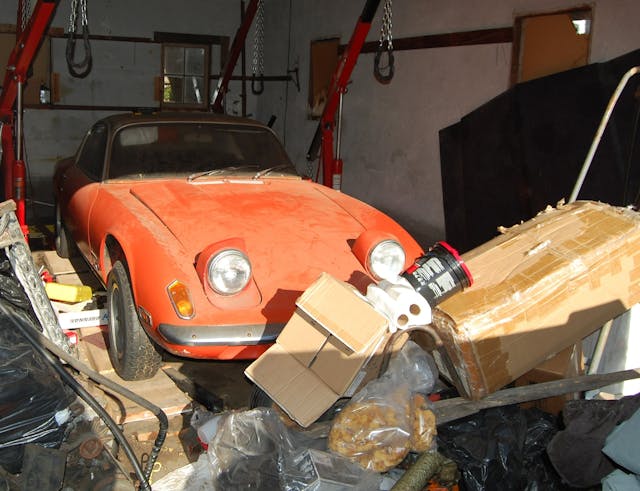
Next were the Eclat’s brakes. I pulled my plastic Rhino Ramps out of my trunk. When Rob saw the substantial lip on the end of the ramps, his skepticism changed to intense interest. We tried to back the Eclat onto the ramps, but it wouldn’t run long enough on starting fluid to do it safely. Rob poured some fresh gas into the little fuel cell that was substituting for the long-removed tank (he’d removed because it was leaking but had never reinstalled its replacement), I turned the key to ignition and left it there until I heard the electric fuel pump’s note change as it filled the float bowl. I started it again, and this time the Rover 3.5 settled into a throaty idle. In one smooth well-controlled motion, the back of the Eclat went onto the ramps. The tires settled reassuringly against the lips.
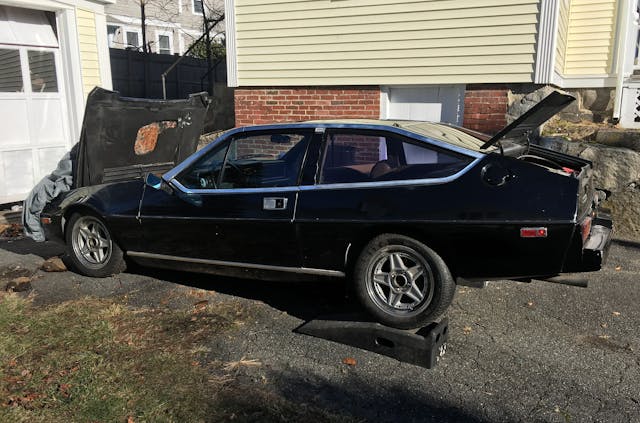
It was clear that Rob thought I wasn’t going to stick around for the duration of the brake bleeding because he repeatedly offered to buy the ramps from me. I kept telling him not to worry about it, that if for some reason I had to go before it was done, he could just hold onto them.
I threw everything I had at bleeding the brakes. For a number of reasons, none of my bleeding tools were effective, and we resorted to me manually pumping the brake pedal while Rob opened and closed the bleed valve, catching the fluid stream in a cardboard box with newspapers in it. It took several go-arounds front to back and left to right, but whatever air was in the system passed, and the pedal became rock-hard. Rob tightened everything back up and put the rubber caps back on the bleed nipples. I made certain he was clear of the car, then started it again and eased it down off the ramps. It came to a controlled stop in front of the garage.
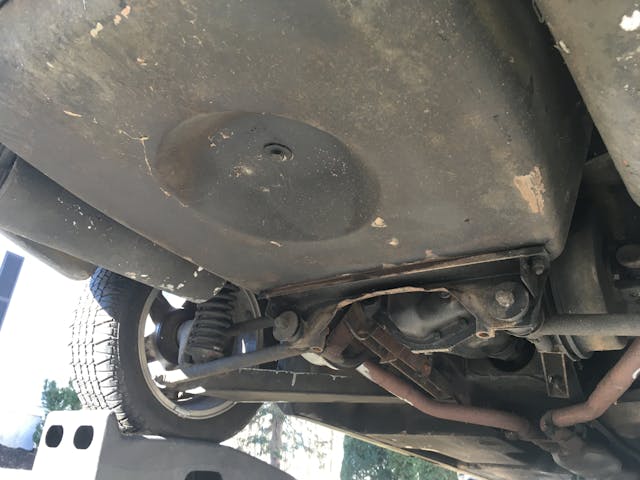
Rob was ecstatic at having working brakes and thus a potentially drivable car. He thanked me profusely and began offering me tools from the garage in gratitude. “Do you have one of these?” he said, handing me the Snap-On flare nut wrench he’d just used on the bleed valves. I demurred. “I can’t take that. It’s too much,” I said. “How about this?” He held out a heavy-gauge battery cable crimping tool. I waived them all off and talked about “pay it forward” and how I’ve been the recipient of automotive generosity and grace more times than I could count. Besides, I’m a car guy. Why wouldn’t I want to help another former software engineer with TWO Lotuses?
But he wouldn’t give up. He pulled out a tub of industrial hand-cleaning wipes. “Do you have these?” he asked. “They’re like Lava soap in cleaning wipes. They’re great.” I admitted that I did not. He put them in the driveway for me. Then he showed me a cool mini-work lamp with a magnet and a tilt stand. “How about these?” he asked. “They’re really handy. USB-rechargeable.”
“I … don’t,” I admitted. “I mainly use my phone. Which is why the screen is cracked.”
“Take two,” he said, thrusting them toward me. “They give very little warning when they’re about to run down. That’s why I bring two whenever I work here.”
“I can’t,” I said. “It’s too much.”
“Come on,” he said. “You just made my car drivable. Besides, I’ve got six of them. I paid 18 bucks each for them at Wal-Mart. Take ’em.” I relented and put them in the driveway next to the tub o’ wipes.
Now came the hard part. I pride myself on being able to ethically switch between wearing the hats of interested buyer, unbiased advice-giver, and all-around good guy. I find that, as long as I’m brutally honest, the only conflict of interest is that I may undercut my own bargaining position, but that’s something I can easily live with. I also pride myself on my incredibly tolerant wife staying married to me, and my being at least somewhat financially solvent by not crossing the threshold of gross stupidity too often.
So, after helping Rob bleed the brakes on the Elcat—which had absolutely nothing to do with whether or not I was interested in the Elan—we finally came back around to the issue of whether or not I was interested in the Elan.
I asked if he’d had any offers on the car. Rob said that he’d received a few out-of-state calls, but no one else had come to look at it. He said that he hoped to get the drivetrain back in the Elan to raise its value. I recounted my experience with my Europa, and how absolutely nothing about reassembling the Twink engine was fast or cheap, even when I did have all the parts, and gently offered that that approach probably wasn’t consonant with his losing his storage space. Because of the incomplete engine, I opined that, whether it’s me or anyone else, the likely future for the car might be a conversion with a Ford Zetec engine, as they’re cheap and have the same bolt pattern as the original Lotus-Ford Twin-Cam (like with any engine swap, though, you pay for it in adaptation costs).
When I want to buy a car, I’ll usually ask, “What do you need to get for it?” This is a far more respectful question than the crass sight-unseen, “What’s the lowest you’ll take for it?” When combined with actually showing up and proving yourself to be a credible person, it can produce some surprising responses. If a seller names a number I like, I’ll shake on it, done. I don’t need to bargain for sport. But once a seller names that number, it’s difficult to respectfully go below it. You’ve asked what they need to get for it. They’ve answered. And, really, I thought it was unlikely that I wanted to buy the Elan for what he probably felt he needed to get for it.
Instead, I began to say, “Rather than make you some insultingly low offer,” but Rob cut me off. “Go ahead,” he said. “At some point, if I get thrown out of the garage, I may not have a lot of options.” As I’ve done with many other people, I told him to get as much for the car as he can, but that, if he reaches the point of needing to get rid of it in a hurry, I own a truck, and with a day or two’s notice I can rent a U-Haul auto transport trailer, show up, and make the car go away. I summarized the issues of the rust on the frame, the rotted sills, the removed drivetrain, the disassembled and incomplete motor, and the fact that the car will likely need every bushing and bit of hydraulics replaced. And in that context, I named a number that probably bordered on being insultingly low but was in fact what I was willing to pay. Some folks call this “vulturing,” but to me, a predatory approach would be to wave cash and say, “When I leave, I take the offer with me,” and that’s not my style. The sell-it-for-as-much-as-you-can approach is fair, credible, and can actually help a seller in a challenging spot. I was, however, surprised that Rob never named a number. But that was OK.
I loaded the ramps and the last of my tools in the car when Rob said, “Are you going to take these or do I have to put them in your trunk for you?” He was pointing at the work lights and the tub of wipes in the driveway. I laughed. It was an honest mistake.
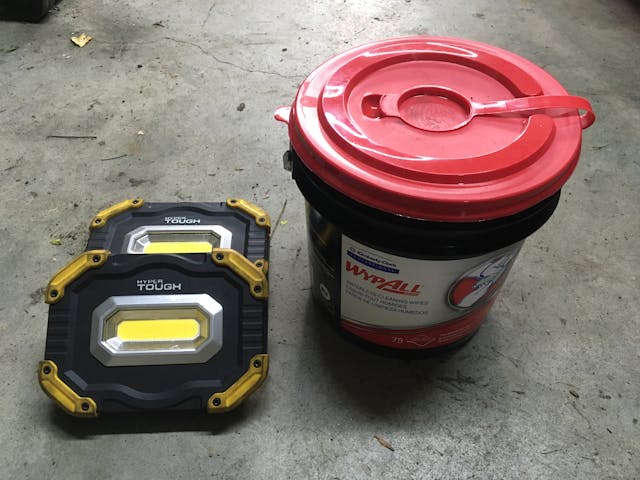
And that was that. No sale, at least not that day.
Three days later, I learned that—and I’ll write a separate piece about this—I’m losing my five rented garage spaces out in central Massachusetts, one was gone by the end of December and the other four by the end of March. I’m not panicking because I suspected this was coming and had already lined up a “Plan B.” I let Rob know this, saying that it made things more complicated, but that I could still make space for the Elan if need be.
The following week, an acquaintance—who, coincidentally, lives in Andover—read a Facebook post of mine about helping Rob with the brakes on the Eclat, independently found the ad for the Elan +2 on Craigslist, and peppered me with questions about it. It turns out that he’d met Rob previously and used to talk British cars with him. A few days later, he said that he was talking with Rob about helping him put the Elan back together and splitting the proceeds when it sells, but when I asked this fellow about space, it turns out he doesn’t have any either.
As New Year’s Day approached, the ads for both cars vanished from Craigslist. I could text Rob and ask him what’s up, but my existing projects have already eaten up the floor space in my garage. Besides, “Is it still available” contact isn’t really fair to anyone unless I want to transition from “vulturing” to actually making something happen, which means opening up the financial faucet.
Oddly enough, I’m going to call this one a win. Passion for cars is a beautiful thing, but I just don’t live on the same planet as folks who have the bankroll to buy the prettiest, shiniest objects or to bring a restoration project up to concours level. When looking at needy cars, the ideal offer is calibrated so that, if the buyer says yes, you’re happy, and if the buyer says no, you’re just as happy. I do hope the automotive currents and tides push the engine-less and endlessly needy Elan +2 to me, but although it is definitely “space worthy,” its cash-worthiness must be treated with extreme caution.
***
Rob Siegel’s new book, The Best of the Hack MechanicTM: 35 years of hacks, kluges, and assorted automotive mayhem, is available on Amazon. His other seven books are available here, or you can order personally-inscribed copies through his website, www.robsiegel.com.
